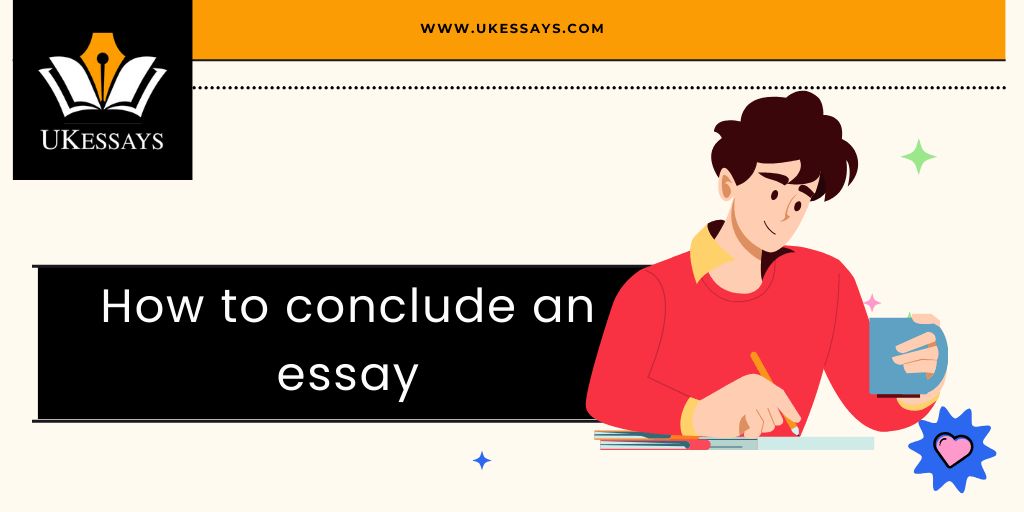How to conclude an essay
Info: 2175 words (9 pages) Study Guides
Published: 29 Sep 2025

Struggling with your essay conclusion? Our writers know exactly how to wrap things up clearly. Get in touch, and let’s finish strong. See our essay writing services page for more info.
Concluding an essay effectively is just as crucial as writing a compelling introduction. The conclusion is the writer’s final opportunity to influence the reader’s understanding and give a sense of closure.
A well-written conclusion leaves a lasting impression, reinforcing the arguments made and highlighting the significance of the discussion. In fact, readers often look at the conclusion to gauge the overall quality and direction of an essay (University of Warwick, n.d.). A strong conclusion ensures the reader feels the essay was worth their time. It also provides a satisfying endpoint to the argument or analysis (UNC Writing Center, 2025).
Key elements of an effective conclusion
An essay’s conclusion should serve several key functions. It is typically a short section (often around 10% of the essay’s length) that brings together the main threads of the discussion (University of Adelaide Writing Centre, 2014). The most important elements of a good conclusion include:
Restating the main argument:
The conclusion should clearly reaffirm the essay’s central thesis or answer to the question, but in different words than used in the introduction. This reminds readers of the core stance or finding that has emerged from the essay.
For example, suppose the thesis is that renewable energy is crucial for sustainable development. In that case, the conclusion might rephrase this idea as a broader statement about how the evidence shows renewables are key to future environmental and economic stability.
Summarising key points:
Briefly summarise the essay’s principal points or findings. This recap should be concise and not merely a repetition of earlier sentences (Naydan, 2025). Instead of exhaustively reviewing every detail, it extracts the essence of the arguments made. The aim is to remind readers of how the supporting points collectively back up the thesis.
Synthesising and demonstrating significance:
An effective conclusion does more than summarise; it synthesises the insights and shows why they matter. Good conclusions explicitly answer the “so what?” question. They explain the significance of the argument and why the reader should care (Naydan, 2025).
For instance, after discussing evidence in an essay, the conclusion might highlight what the findings imply. It can point out the broader implications for understanding the topic or for future practice. By doing so, the conclusion provides the reader with a clear sense of the essay’s importance in a wider context.
Providing closure:
The conclusion should signal that the discussion is complete and that the essay has answered or resolved the question posed at the outset. It should give the reader a sense of finality.
Achieving closure might involve linking back to an idea or example from the introduction, thereby bringing the argument full circle. This symmetry between opening and closing helps the essay feel cohesive and complete.
A final impactful statement:
Often, an effective conclusion will end with a strong final sentence that reinforces the essay’s main message or provides a parting insight. This final statement could take many forms. For example, it might be a broad implication of the argument or a rhetorical question.
Alternatively, it could serve as a call to action or a thoughtful reflection drawn from the essay’s analysis. The final sentence is the author’s last word on the subject, so it should leave a memorable impression on the reader.
Strategies for writing a strong conclusion
Writing a conclusion can be challenging, but there are proven strategies and techniques that can help:
Echo the introduction:
One way to give a sense of completeness is to revisit a theme, scenario, or question raised in your introduction. For example, say an essay opened with an anecdote or a provocative question.
In the conclusion, you would refer back to it to show how the essay has shed light on that situation. This technique of coming “full circle” helps emphasise that the essay has addressed the initial problem or question, thereby reinforcing unity (UNC Writing Center, 2025).
Play the “So what?” game:
As you draft your conclusion, continually ask yourself “So what?” for each statement you make. This strategy forces you to articulate why each point you raised is significant (UNC Writing Center, 2025).
If you state a finding, consider why it matters in the grand scheme of things. Think about its implications for society, for a particular field of study, or for future research. Answering “So what?” ensures your conclusion conveys the relevance and consequences of your argument, rather than simply rehashing points.
Synthesise, don’t just summarise:
While a brief summary of key points is useful, avoid simply repeating information from the body of the essay. Instead, show how those points fit together to support the thesis. For instance, rather than listing each argument again, you might explain how taken together, the evidence presented paints a coherent picture or leads to a logical final inference.
This approach demonstrates a deeper understanding, as it draws connections between points and builds to the essay’s overall conclusion (University of North Carolina Writing Center, 2025).
Highlight broader implications or future directions:
A strong conclusion may broaden the focus to consider the implications of your argument. Depending on the topic, you might suggest what the findings mean for the field or for real-world applications. In academic essays, it can be appropriate to note any remaining questions or recommend areas for further investigation (University of Adelaide Writing Centre, 2014).
For example, after arguing about a historical trend, you might point out how that understanding could inform present-day policy. If you have analysed a scientific problem, you could propose a next step for research. However, ensure this is done without introducing entirely new evidence. The goal is to show that your essay’s insights extend beyond its immediate scope, giving readers something to ponder after finishing the essay.
Use a confident and scholarly tone:
Keep the tone of the conclusion formal and assured, in line with the rest of your essay. Avoid weak phrases like “I hope you enjoyed this essay” or any apologetic wording that undermines your argument. Instead, project confidence in the conclusions you have drawn.
It is acceptable to convey your own reasoned perspective in the final paragraph (Trzeciak and Mackay, 1994), but do so without resorting to overt phrases such as “I think”. For example, rather than writing “In conclusion, I think climate change is a serious issue,” an assertive alternative would be: “Overall, the evidence indicates that climate change poses a serious challenge that demands urgent action.” This way, you present your stance clearly and authoritatively.
Keep it concise and focused:
Aim for brevity and clarity. As a guideline, the concluding section should be clear and relatively brief compared to the main body (Trzeciak and Mackay, 1994). Avoid going off on tangents or including irrelevant information at the end. Every sentence in the conclusion should contribute to wrapping up the essay’s argument.
If you find yourself introducing a new point or a piece of evidence in the conclusion, reconsider placing it in the body instead. A focused conclusion helps maintain the “balance” of the essay, ensuring the ending is not disproportionately long or filled with extraneous details.
End on an impactful note:
Craft the final sentence carefully. This last sentence should give the reader a lasting insight or a sense of resolution. Depending on the essay type, it could be a call to action (“These findings underscore the need for policymakers to address…”), a reflective thought (“Ultimately, society’s response to this issue will define its legacy for future generations.”), or a concluding deduction that emphasises the essay’s main message one last time. A strong closing sentence will resonate with the reader and reinforce that the essay’s journey was meaningful and conclusive.
Common pitfalls to avoid
When drafting your conclusion, be mindful of several common mistakes that can weaken an otherwise good essay:
Introducing new information:
A conclusion is not the place to present new arguments, evidence, or examples. Adding new facts or ideas in the final paragraph can confuse readers and make the essay feel incomplete or unbalanced.
If a point is important enough to mention, it belongs in the body of the essay, not in the conclusion (University of Adelaide Writing Centre, 2014). Stick to synthesising the material already covered rather than surprising the reader with new content.
Repetition without insight:
Simply restating your thesis or copying sentences from the introduction can make the conclusion dull and redundant. Phrases like “In conclusion, this essay discussed…” followed by a verbatim list of points add little value.
Instead of mechanical repetition, aim to rephrase and condense your main points while also indicating what the overall argument has demonstrated. The reader should feel that the conclusion is adding a layer of understanding, not just rehashing the essay.
Overused closing phrases:
Starting the conclusion with stock phrases such as “In conclusion,” “In summary,” or “In closing” is generally unnecessary in academic writing. Readers can see they have reached the end of the paper, so overt signposting can seem wooden and trite (UNC Writing Center, 2025).
Moreover, if the word “conclusion” appears multiple times throughout the essay (for example, in subheadings or earlier sections), it can mislead or irritate the reader (University of Warwick, n.d.). It is better to craft a natural transition into your final statements without relying on clichés.
Changing the tone or making emotional appeals:
A sudden shift to an overly emotional or sentimental tone in the conclusion can undermine an analytical essay. Maintain a consistent, objective voice. For instance, avoid grandiose proclamations (“This proves that justice will always prevail!”) or personal appeals that were not present in the body. While the conclusion can be eloquent and even impassioned, it should align with the evidence-based tone of the essay.
Undermining your argument:
Be careful not to use the conclusion to doubt or weaken your own thesis. Phrases that sound unsure, like “There might be other perspectives, and this is just one possibility,” can erode the authority you have built. While it is fine to acknowledge limitations of your analysis if relevant, do so in a way that still affirms the validity of your conclusions. The final paragraph should project confidence in the essay’s findings.
Excessive length or brevity:
A conclusion that is too long may reintroduce too much detail and dilute the impact of the closing. Conversely, a one- or two-sentence conclusion is likely too short to be effective (unless you are working under extreme word limits). Strive for a happy medium: enough content to wrap up the argument properly, but not so much that the conclusion drags on. Ensuring the conclusion remains proportionate to the essay’s length is key (University of Warwick, n.d.).
Tailoring the conclusion to your essay or discipline
While the general principles of writing a conclusion apply across most essays, it is also important to consider the expectations of your specific assignment or academic discipline:
Disciplinary conventions:
Academic disciplines sometimes have specific expectations for conclusions. In scientific research papers or lab reports, the conclusion (often titled “Discussion”) not only summarises the findings but also addresses limitations and may suggest future research.
By contrast, a humanities essay conclusion tends to discuss the broader significance of the argument or analysis.
Always follow any guidelines given for your assignment. For example, some technical or mathematical tasks (especially those that are primarily problem-solving) may not require a standalone concluding paragraph at all (University of Warwick, n.d.).
Consistency with introduction and body:
Ensure that the conclusion aligns with the aims stated in the introduction and the arguments developed in the body.
If your introduction set out certain questions, the conclusion should address them. If you provided a roadmap of the essay’s structure early on (“This essay will examine X, Y, and Z…”), the conclusion should follow up on each of those points in its final summary.
This consistency reassures the reader that the essay has fulfilled its aims and has not left loose ends.
Struggling with your essay conclusion? Our writers know exactly how to wrap things up clearly. Get in touch, and let’s finish strong. See our essay writing services page for more info.
References and further reading:
- Naydan, L. (2025) How Do I Write an Intro, Conclusion, & Body Paragraph? Sweetland Center for Writing, University of Michigan. [Online]. Available at: https://lsa.umich.edu/sweetland/undergraduates/writing-guides/how-do-i-write-an-intro–conclusion—-body-paragraph.html (Accessed 29 September 2025).
- Trzeciak, J. and Mackay, S. E. (1994) Study Skills for Academic Writing. New York: Prentice Hall.
- University of Adelaide Writing Centre (2014) Introductions & Conclusions: Writing Centre Learning Guide. University of Adelaide. [Online]. Available at: https://www.adelaide.edu.au/writingcentre/ua/media/14/learningguide-introductionsconclusions.pdf (Accessed 29 September 2025).
- University of North Carolina Writing Center (2025) Conclusions. University of North Carolina at Chapel Hill. [Online]. Available at: https://writingcenter.unc.edu/tips-and-tools/conclusions/ (Accessed 29 September 2025).
- University of Warwick (n.d.) Writing a Conclusion. University of Warwick Academic Skills Program. [Online]. Available at: https://warwick.ac.uk/fac/soc/al/globalpad-rip/openhouse/academicenglishskills/writing/conclusions/ (Accessed 29 September 2025).
Cite This Work
To export a reference to this article please select a referencing stye below:



